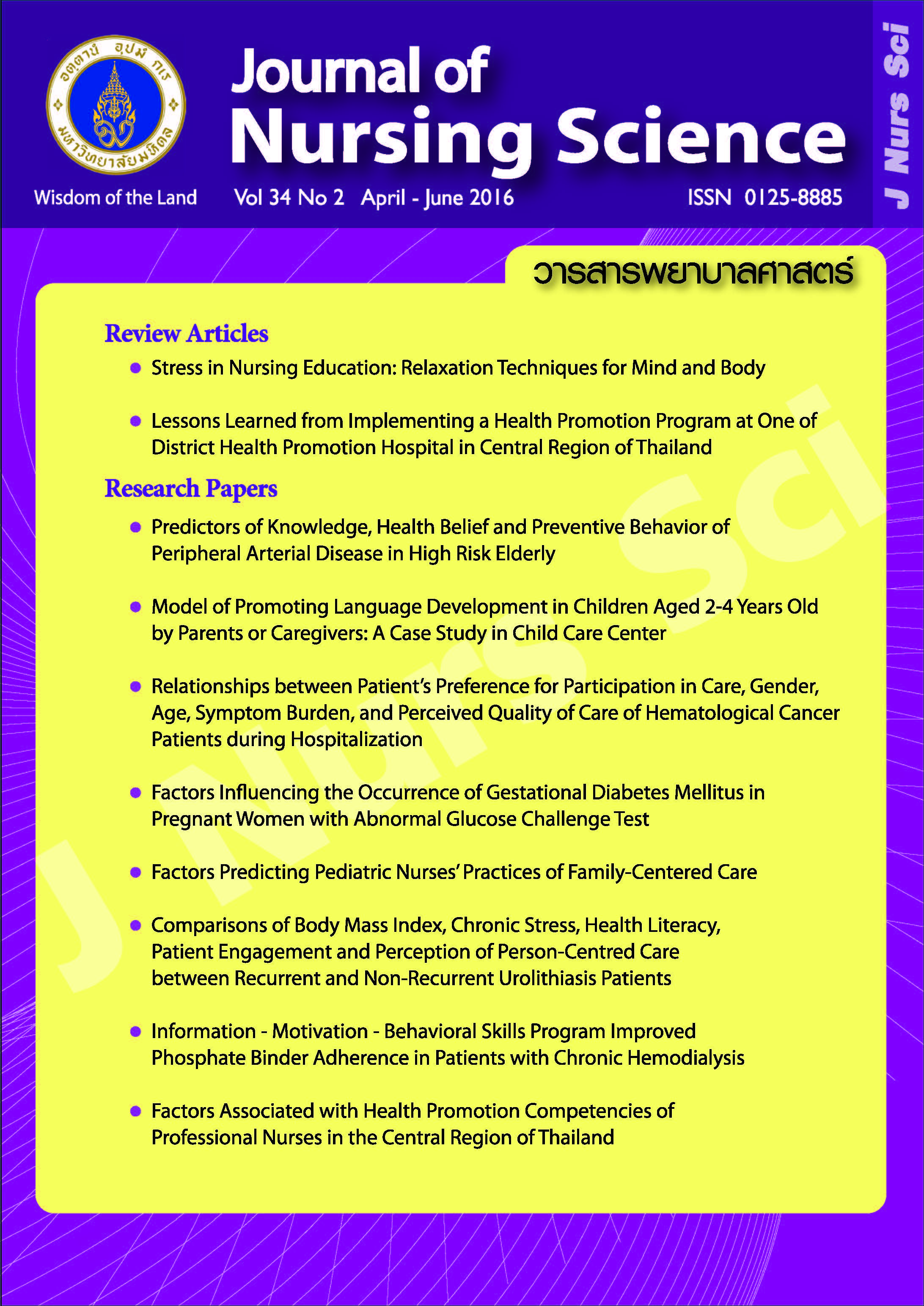Comparisons of Body Mass Index, Chronic Stress, Health Literacy, Patient Engagement and Perception of Person-Centred Care between Recurrent and Non-Recurrent Urolithiasis Patients
Main Article Content
Abstract
Abstract
Purposes: To compare body mass index, chronic stress, health literacy, patient engagement and perception of person-centred care between recurrent and non-recurrent urolithiasis patients.
Design: Comparative descriptive research design.
Methods: The samples consisted of patients with urolithiasis after complete removal of stone at least six months, 150 recurrent and 150 non-recurrent. Data were collected using 5 questionnaires: Personal data record form, Perceived Stress scale, Health Literacy Questionnaire, Patient Activation Measure, and the Consultation Care Measure. Data were analyzed using descriptive statistics and a comparison Z-test.
Main Findings: The findings showed that non-recurrent urolithiasis patients perceived chronic stress at low level (X = 6.25, SD = 4.86); an average score of health literacy was 439.21 (SD = 39.78), patient engagement was high level (X = 63.88, SD = 12.90) while those with recurrent urolithiasis perceived chronic stress at medium level (X = 12.75, SD = 5.23), an average score of health literacy was 336.07 (SD = 41.22 ), patient engagement was low level (X = 40.33, SD = 9.44). All of the three factors were significant different (p < .05) between two groups. While body mass index and the perception of a person-centred care were not significant different between two groups.
Conclusion and recommendations: Nurses should organize health-promoting activities for urolithiasis patients during and after stone removal using various methods to reduce chronic stress, promote health literacy and patient engagement in order to prevent recurrent urolithiasis.
Keywords: body mass index, chronic stress, health literacy, patient engagement, person-centred care, urolithiasis patients
เปรียบเทียบดัชนีมวลกาย ความเครียดเรื้อรัง ความแตกฉานทางสุขภาพ ความรับผิดชอบของผู้ป่วย และการรับรู้การดูแลแบบบุคคลเป็นศูนย์กลางระหว่างผู้ป่วยที่เป็นนิ่วในระบบทางเดินปัสสาวะซ้ำและผู้ที่ไม่เป็นซ้ำ
บทคัดย่อ
วัตถุประสงค์: เพื่อศึกษาเปรียบเทียบดัชนีมวลกาย ความเครียดเรื้อรัง ความแตกฉานทางสุขภาพ ความรับผิดชอบของผู้ป่วย และการรับรู้การดูแลแบบบุคคลเป็นศูนย์กลาง ระหว่างผู้ป่วยที่เป็นนิ่วในระบบทางเดินปัสสาวะซ้ำ และผู้ที่ไม่เป็นซ้ำ
รูปแบบการวิจัย: การศึกษาเชิงบรรยายเปรียบเทียบ
วิธีดำเนินการวิจัย: ผู้ป่วยนิ่วในระบบทางเดินปัสสาวะที่มาติดตามอาการภายหลังรักษานิ่วครั้งแรกออกหมดมีระยะเวลาห่างจากการรักษาครั้งแรกไม่ต่ำกว่า 6 เดือน กลุ่มที่เป็นนิ่วซ้ำ และไม่เป็นซ้ำ กลุ่มละ 150 ราย รวมทั้งหมด 300 ราย เก็บรวบรวมข้อมูลโดยการสัมภาษณ์ เครื่องมือที่ใช้ในการเก็บข้อมูลประกอบด้วย แบบบันทึกข้อมูลส่วนบุคคล แบบประเมินการรับรู้ความเครียด แบบประเมินความแตกฉานทางสุขภาพ แบบประเมินความรับผิดชอบของผู้ป่วย และ แบบประเมินการรับรู้การดูแลแบบบุคคลเป็นศูนย์กลาง วิเคราะห์ข้อมูลโดยสถิติเชิงพรรณนาและสถิติเปรียบเทียบ
ผลการวิจัย: กลุ่มตัวอย่างที่ไม่เป็นนิ่วซํ้ามีความเครียดเรื้อรังอยู่ในระดับตํ่า (X = 6.25, SD = 4.86) มีความแตกฉานทางสุขภาพเท่ากับ 439.21 (SD = 39.78) มีความรับผิดชอบของผู้ป่วยอยู่ในระดับสูง (X = 63.88, SD = 12.90) ในขณะกลุ่มที่เป็นนิ่วซํ้ามีความเครียดเรื้อรังระดับปานกลาง (X = 12.75, SD = 5.23) มีความแตกฉานทางสุขภาพเท่ากับ 336.07 (SD = 41.22 ) มีความรับผิดชอบของผู้ป่วยอยู่ในระดับต่ำ (X = 40.33, SD = 9.44) ซึ่งทั้งสามปัจจัยมีความแตกต่างกันอย่างมีนัยสำคัญทางสถิติระหว่างกลุ่มเป็นนิ่วซํ้าและไม่เป็นซํ้า สำหรับดัชนีมวลกายและการรับรู้การดูแลแบบบุคคลเป็นศูนย์กลางระหว่างกลุ่มเป็นนิ่วซ้ำ และไม่เป็นซ้ำความแตกต่างกันอย่างมีนัยสำคัญทางสถิติ
สรุปและข้อเสนอแนะ: พยาบาลและบุคคลากรทางสุขภาพควรตระหนัก และให้การดูแลผู้ป่วยโดยลดความเครียดเรื้อรัง ส่งเสริมความแตกฉานทางสุขภาพ และความรับผิดชอบของผู้ป่วยทั้ง ขณะและภายหลังการรักษาเอานิ่วออก เพื่อป้องกันการกลับเป็นนิ่วซ้ำ
คำสำคัญ: ดัชนีมวลกาย ความเครียดเรื้อรัง ความแตกฉานทางสุขภาพ ความรับผิดชอบของผู้ป่วย การรับรู้การดูแลแบบบุคคลเป็นศูนย์กลาง นิ่วในระบบทางเดินปัสสาวะ
Article Details
Copyright Notice: Nursing Science Journal of Thailand has exclusive rights to publish and distribute the manuscript and all contents therein. Without the journal’s permission, the dissemination of the manuscript in another journal or online, and the reproduction of the manuscript for non-educational purpose are prohibited.

Disclaimer: The opinion expressed and figures provided in this journal, NSJT, are the sole responsibility of the authors. The editorial board bears no responsibility in this regard.


